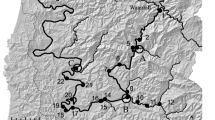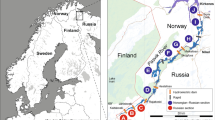Abstract
Comparing the ratio of effective number of breeders (N b ) to adult population size (N) among closely related coexisting species can provide insights into the role of life history on N b /N ratios and inform conservation programs towards limiting the loss of evolutionary potential in natural populations. We estimated N b and N in two coexisting salmonid fishes (Brook trout and Atlantic salmon) for 3–4 consecutive years in two small, adjacent streams in Newfoundland, Canada, using mark-recapture (N), linkage disequilibrium (N b(LD)), and sibship frequency approaches (N b(Sib) ). We found that N b /N ratios were about 20-fold greater in Atlantic salmon than in brook trout (mean 0.20, range 0.06–0.56 vs. mean 0.02, range 0.01–0.05, respectively). This difference was consistent across N b estimators. In addition, we found that removing migrants reduced N b : the strength of the effect was weak for N b(LD) and much stronger for N b(Sib). Our results highlight the importance of subtle ecological differences and gene flow in sha** N b /N. They also provide some evidence that the linkage between demographic and evolutionary processes varies between closely related taxa and suggest that a more complete understanding of the N b /N range across various species is an important component of conservation genetics and management.


Similar content being viewed by others
References
Anderson EC, Dunham KK (2008) The influence of family groups on inferences made with the program Structure. Mol Ecol Resour 8:1219–1229
Ardren WR, Kapuscinski AR (2003) Demographic and genetic estimates of effective population size (Ne) reveals genetic compensation in steelhead trout. Mol Ecol 12:35–49
Belmar-Lucero S, Wood J, Scott S et al (2012) Concurrent habitat and life history influences on effective/census population size ratios in stream-dwelling trout. Ecol Evol 2:563–573
Bernos TA, Fraser DJ (2016) Spatiotemporal relationship between adult census size and genetic population size across a wide population size gradient. Mol Ecol 25:4472–4487
Blanchfield PJ, Ridgway MS (1997) Reproductive timing and use of redd sites by lake-spawning brook trout (Salvelinus fontinalis). Can J Fish Aquatic Sci 54:747–756
Blanchfield PJ, Ridgway MS (2005) The relative influence of breeding competition and habitat quality on female reproductive success in lacustrine brook trout (Salvelinus fontinalis). Can J Fish Aquatic Sci 62:2694–2705
Consuegra S, Verspoor E, Knox D, García De Leániz C (2005) Asymmetric gene flow and the evolutionary maintenance of genetic diversity in small, peripheral Atlantic salmon populations. Conserv Genet 6:823–842
Curry RA, Neakes DLG (1995) Groundwater and the selection of spawning sites by brook trout (Salvelinus fontinalis). Can J Aquatic Sci 52:1733–1740
Curry RA, Noakes DLG, Curry RA, Neakes DLG (1995) Groundwater and the selection of spawning sites by brook trout (Salvelinus fontinalis). Can J Fish Aquatic Sci 52:1733–1740
Earl DA, VonHoldt BM (2012) STRUCTURE HARVESTER: a website and program for visualizing STRUCTURE output and implementing the Evanno method. Conserv Genet Resour 4:359–361
Evanno G, Regnaut S, Goudet J (2005) Detecting the number of clusters of individuals using the software STRUCTURE: a simulation study. Mol Ecol 14:2611–2620
Ferchaud A-L, Perrier C, April J et al (2016) Making sense of the relationships between Ne, Nb and Nc towards defining conservation thresholds in Atlantic salmon (Salmo salar). Heredity 117:268–278
Fleming IA (1996) Reproductive strategies of Atlantic salmon: ecology and evolution. Rev Fish Biol Fisheries 6:379–416
Frankham R (1995) Effective population size/adult population size ratios in wildlife: a review. Genet Res 66:95–107
Frankham R, Bradshaw CJ, Brook BW (2014) Genetics in conservation management: revised recommendations for the 50/500 rules, red list criteria and population viability analyses. Biol Conserv 170:56–63
Fraser DJ, Lippe C, Bernatchez L (2004) Consequences of unequal population size, asymmetric gene flow and sex-biased dispersal on population structure in brook charr (Salvelinus fontinalis). Mol Ecol 13:67–80
Gibson RJ, Williams DD, McGowan C, Davidson WS (1996) The ecology of dwarf fluvial Atlantic salmon, Salmo Salar L., cohabiting with brook trout, Salvelinus fontinalis (Mitchill), in Southeastern Newfoundland, Canada. Polskie Arch Hidrobiol 43:145–166
Gilbert KJ, Whitlock MC (2015) Evaluating methods for estimating local effective population size with and without migration. Evol Int J Org Evol 69:2154–2166
Gomez-Uchida D, Knight TW, Ruzzante DE (2009) Interaction of landscape and life history attributes on genetic diversity, neutral divergence and gene flow in a pristine community of salmonids. Mol Ecol 18:4854–4869
Gomez-Uchida D, Palstra FP, Knight TW, Ruzzante DE (2013) Contemporary effective population and metapopulation size (Ne and meta-Ne): comparison among three salmonids inhabiting a fragmented system and differing in gene flow and its asymmetries. Ecol Evol 3:569–580
Guillemette F, Vallee C, Bertolo A, Magnan P (2011) The evolution of redd site selection in brook charr in different environments†¯: same cue, same benefit for fitness. Freshw Biol 56:1017–1029
Hearn WE (1987) Interspecific competition and habitat segregation among stream-dwelling trout and salmon: a review. Fisheries 12:24–31
Hua YG, Orban L (2005) A simple and affordable method for high throughput DNA extraction from animal tissues for PCR. Electrophoresis 26:3081–3083
Hutchings JA (1993) Adaptive life histories effected by age-specific survival and growth rate. Ecology 74:673–684
Hutchings JA (1994) Age- and size- specific costs of reproduction within populations of brook trout, Salvelinus fontinalis. Nordic Soc Oikos 70:12–20
Jones OR, Wang J (2010) COLONY: A program for parentage and sibship inference from multilocus genotype data. Mol Ecol Resour 10:551–555
Kanno Y, Letcher BH, Hitt NP et al (2015) Seasonal weather patterns drive population vital rates and persistence in a stream fish. Global Change Biol 21:1856–1870
Kanno Y, Pregler KC, Hitt NP et al (2016) Seasonal temperature and precipitation regulate brook trout young-of-the-year abundance and population dynamics. Freshw Biol 61:88–99
King TL, Eackles MS, Letcher BH (2005) Microsatellite DNA markers for the study of Atlantic salmon (Salmo salar) kinship, population structure, and mixed-fishery analyses. Mol Ecol Notes 5:130–132
Luikart G, Ryman N, Tallmon DA, Schwartz MK, Allendorf FW (2010) Estimation of census and effective population sizes: the increasing usefulness of DNA-based approaches. Conserv Genet 11:355–373
Macmillan JL, Caissie D, Marshall TJ, Hinks L (2008) Population indices of brook trout (Salvelinus fontinalis), Atlantic salmon (Salmo salar), and salmonid competitors in relation to summer water temperature and habitat parameters in 100 streams in Nova Scotia. Can Tech Rep Fish Aquat Sci 2819:41
Myhre AM, Engen S, Sæther B (2016) Effective size of density-dependent populations in fluctuating environments. Evol Int J Org Evol 70:2431–2446
Osborne MJ, Davenport SR, Hoagstrom CW, Turner TF (2010) Genetic effective size, Ne, tracks density in a small freshwater cyprinid, Pecos bluntnose shiner (Notropis simus pecosensis). Mol Ecol 19:2832–2844
Palstra FP, Fraser DJ (2012) Effective/census population size ratio estimation: a compendium and appraisal. Ecol Evol 2:2357–2365
Palstra FP, Ruzzante DE (2008) Genetic estimates of contemporary effective population size: What can they tell us about the importance of genetic stochasticity for wild population persistence? Mol Ecol 17:3428–3447
Paterson S, Piertney SB, Knox D, Gilbey J, Verspoor E (2004) Characterization and PCR multiplexing of novel highly variable tetranucleotide Atlantic salmon (Salmo solar L.) microsatellites. Mol Ecol Notes 4:160–162
Perrier C, Normandeau E, Dionne M, Richard A, Bernatchez L (2014) Alternative reproductive tactics increase effective population size and decrease inbreeding in wild Atlantic salmon. Evol Appl 7:1094–1106
Petersen C (1985) The yearly immigration of young plaice into the Limfjord from the German Sea. Rep Dan Biol Stn 5:5–84
Phillipsen I, Funk W, Hoffman E, Monsen KJ, Blouin MS (2011) Comparative analyses of effective population size within and among species: ranid frogs as a case study. Evol Int J org Evol 65:2927–2946
Piry S, Alapetite A, Cornuet JM et al (2004) GENECLASS2: a software for genetic assignment and first-generation migrat detection. J Hered 95:536–539
Pritchard JK, Stephens M, Donnelly P (2000) Inference of population structure using multilocus genotype data. Genet Soc Am 155:945–959
Rannala B, Mountain JL (1997) Detecting immigration by using multilocus genotypes. Proc Natl Acad Sci 94:9197–9201
Raymond M, Rousset F (1995) GENEPOP (version 1.2): population genetics software for exact tests and ecumenicism. J Hered 86:248–249
Ryan P, Kerekes J (1988) Characteristics of sport fish populations in six experimentally fished Salmonid lakes of Gros Morne National Park, Newfoundland. Canadian Technical Report of Fisheries and Aquatic Sciences, St. John’s, Newfoundland, p. 172
Wang J (2004) Sibship reconstruction from genetic data with ty** errors. Genet Soc Am 1979:1963–1979
Wang J (2016) A comparison of single-sample estimators of effective population sizes from genetic marker data. Mol Ecol 25:4692–4711
Waples RS (2005) Genetic estimates of contemporary effective population size: to what time periods do the estimates apply? Mol Ecol 14:3335–3352
Waples RS, Antao T (2014) Intermittent breeding and constraints on litter size: consequences for effective population size per generation (Ne) and per reproductive cycle (Nb). Evol Int J Org Evol 68:1722–1734
Waples RS, Do C (2008) LDNE: a program for estimating effective population size from data on linkage disequilibrium. Mol Ecol Resour 8:753–756
Waples RS, Do C (2010) Linkage disequilibrium estimates of contemporary Ne using highly variable genetic markers: a largely untapped resource for applied conservation and evolution. Evol Appl 3:244–262
Waples RS, England PR (2011) Estimating contemporary effective population size on the basis of linkage disequilibrium in the face of migration. Genetics 189:633–644
Waples RS, Waples RS (2016) Making sense of genetic estimates of effective population size. Mol Ecol 25:4690–4691
Waples RS, Luikart G, Faulkner JR, Tallmon DA (2013) Simple life-history traits explain key effective population size ratios across diverse taxa. Proc R Soc Lond B 280:20131339
Waples RS, Antao T, Luikart G (2014) Effects of overlap** generations on linkage disequilibrium estimates of effective population size. Genetics 197:769–780
Whiteley AR, Coombs JA, Hudy M et al (2013) Fragmentation and patch size shape genetic structure of brook trout populations. Can J Fish Aquatic Sci 688:678–688
Whiteley AR, Coombs JA, Cembrola M et al (2015) Effective number of breeders provides a link between interannual variation in stream flow and individual reproductive contribution in a stream salmonid. Mol Ecol 24:3585–3602
Whiteley AR, Coombs JA, Donnell MJO, Nislow KH, Letcher BH (2017) Kee** things local: subpopulation Nb and Ne in a stream network with partial barriers to fish migration. Evol Appl 348–365
Wilson GA, Rannala B (2003) Bayesian inference of recent migration rates using multilocus genotypes. Genet Soc Am 1191:1177–1191
Wood JLA, Belmar-Lucero S, Hutchings IJ, Fraser DJ (2014) Relationship of habitat variability to population size in a stream fish. Ecol Appl 24:1085–1100
Wood JLA, Yates MC, Fraser DJ (2016) Are heritability and selection related to population size in nature? Meta-analysis and conservation implications. Evol Appl 9:640–657
Yates M., Bernos TA, Fraser DJ (2017) A critical assessment of estimating census population size from genetic population size (or vice versa) in three fishes. Evol Appl. doi:10.1111/eva.12496
Acknowledgements
We thank S. Smart, P. Debes, J-M. Matte, K. Marin and M. Heath for fieldwork, as well as Dr. John Carlos Garza and two anonymous reviewers for their helpful comments on previous versions of this manuscript. This research was funded by a Natural Sciences and Engineering Research Council of Canada (NSERC) Discovery Grant and Accelerator Award to D.J. Fraser, a Vladimir J. Elgart Graduate Entrance Scholarship and two Quebec Center for Biodiversity Science (QCBS) awards to T.A. Bernos, and an NSERC PGS Scholarship to M. Yates.
Author information
Authors and Affiliations
Corresponding authors
Electronic supplementary material
Below is the link to the electronic supplementary material.
Rights and permissions
About this article
Cite this article
Bernos, T.A., Yates, M.C. & Fraser, D.J. Fine-scale differences in genetic and census population size ratios between two stream fishes. Conserv Genet 19, 265–274 (2018). https://doi.org/10.1007/s10592-017-0997-8
Received:
Accepted:
Published:
Issue Date:
DOI: https://doi.org/10.1007/s10592-017-0997-8




